This post may contain affiliate links. Please read our disclosure policy.
This is the most authentic homemade Italian Pappardelle Pasta Recipe. Follow the EASY step by step photo instructions and enjoy this therapeutic pasta making experience. Only 3 basic ingredients!
Pappardelle are wide ribbons of gorgeous egg pasta that are simple and fun to make. If you’ve never made fresh pasta these egg noodles are a great place to start.
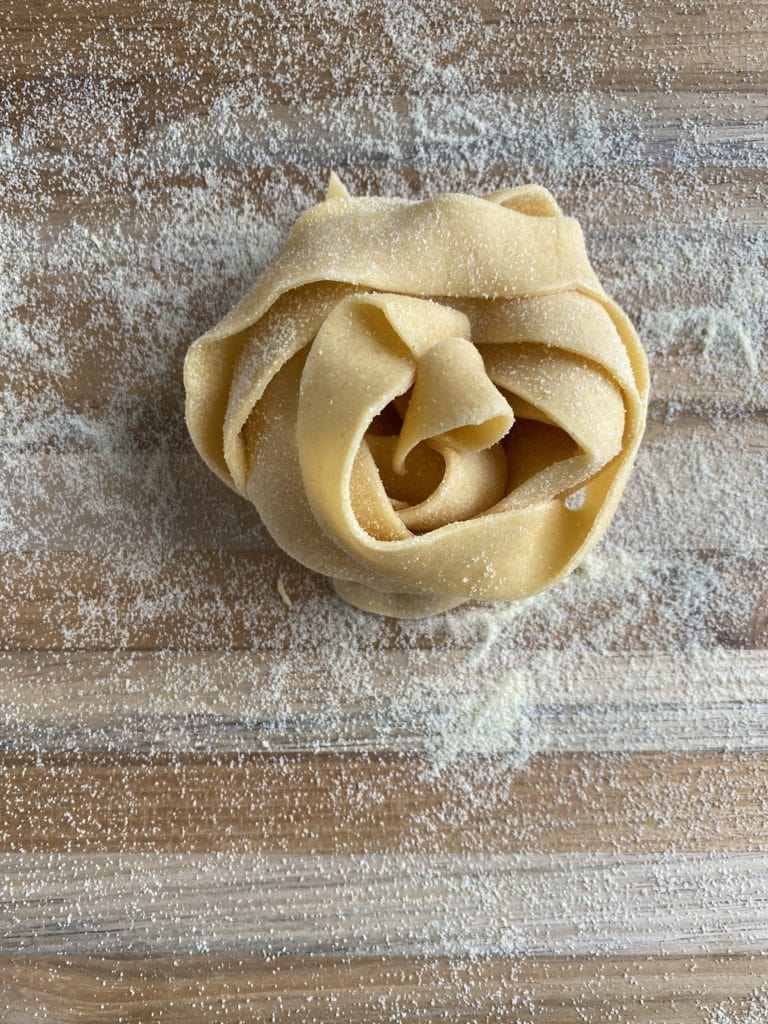
Homemade Pappardelle Pasta
Why you will love this recipe
The perfect meal when you crave a big bowl pasta. It also makes an impressive dish for family and friends.
Fresh Pappardelle pasta are absolutely delicious with a hearty sauces or creamy sauce. Make sure to try these recipes- Pappardelle in Creamy Mascarpone Mushroom Sauce and BEST Italian Beef Short Rib Ragu. For a simple preparation try classic tomato sauce. You could even serve these with a drizzle of olive oil and some fresh parmesan cheese on top.
And check out how you can store your pasta without sticking!
Ingredients
There are only a few simple ingredients to make the most delicious homemade egg pasta. Quality is important since there aren’t many ingredients.
- Eggs (room temperature). I suggest free-range eggs that have rich yellow/orange yolks. This will add rich and beautiful color and enhance the taste of your pasta.
- Flour. I prefer Italian fine ground 00 flour or all-purpose flour.
- Semolina. This recipe doesn’t use semolina in the dough. It is used for dusting the pasta once it is finished. You can use flour, but it changes the cooking a bit and can make them a little heavier, or not as light.
See the recipe card for quantities.
Tools
- Wood cutting board or counter top
- Fork
- Rolling pin OR pasta machine
- Sharp Knife
- Plastic wrap
- Tea towel (lightweight towel)
- Bench scraper (optional)
- Kitchen scale (recommended)
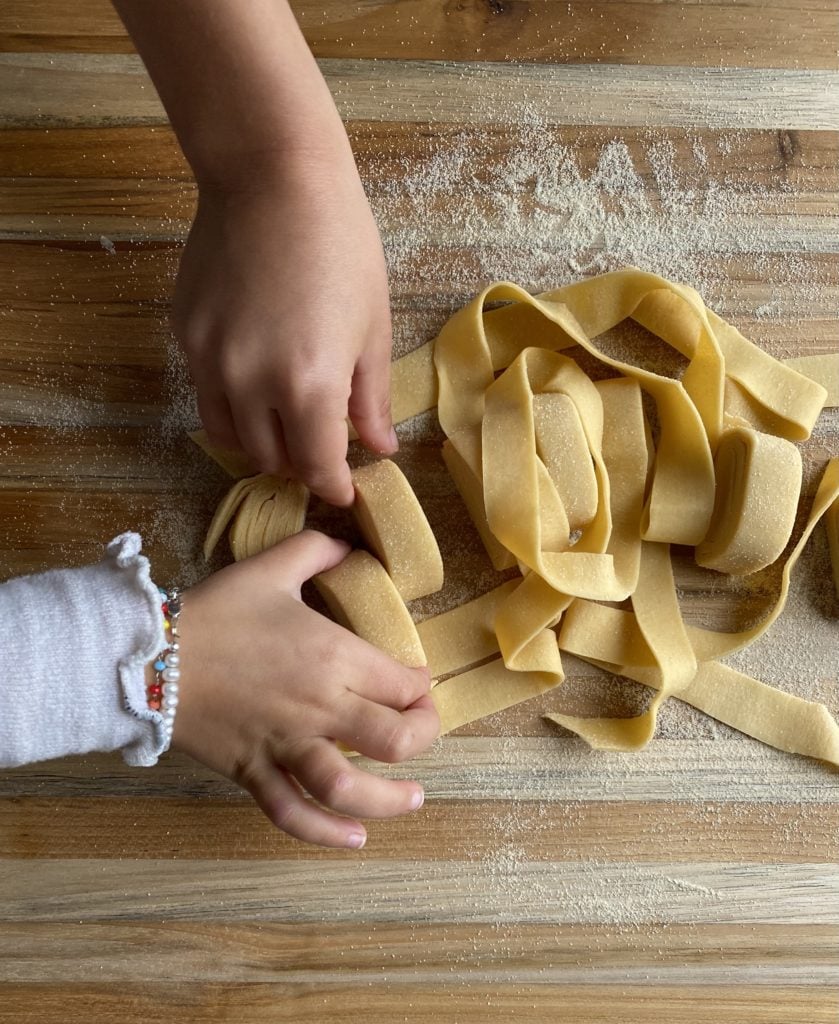
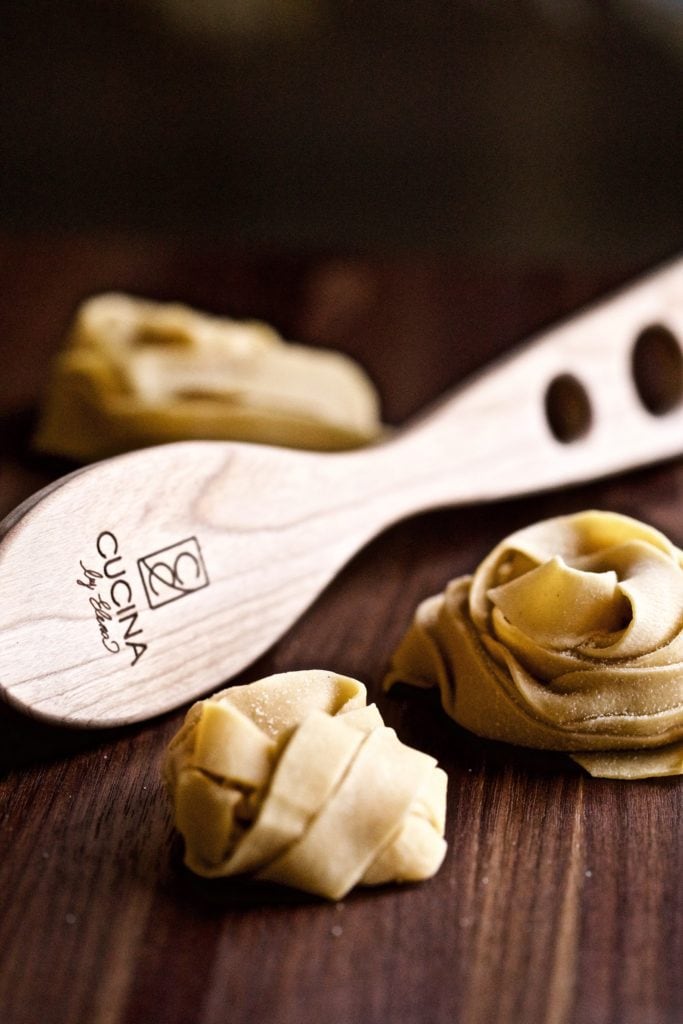
I generally always use “00” flour. This is a finely ground Italian flour that produces optimal results for making fresh pasta. If you are in a bind you may also use all-purpose flour.
I find it is easier to mix a uniform dough when using the Italian 00 flour since it is so fine.
The Spruce Eats talks about this in more detail in this article.
How To Make Pappardelle Pasta
Make the Fresh Pasta Dough
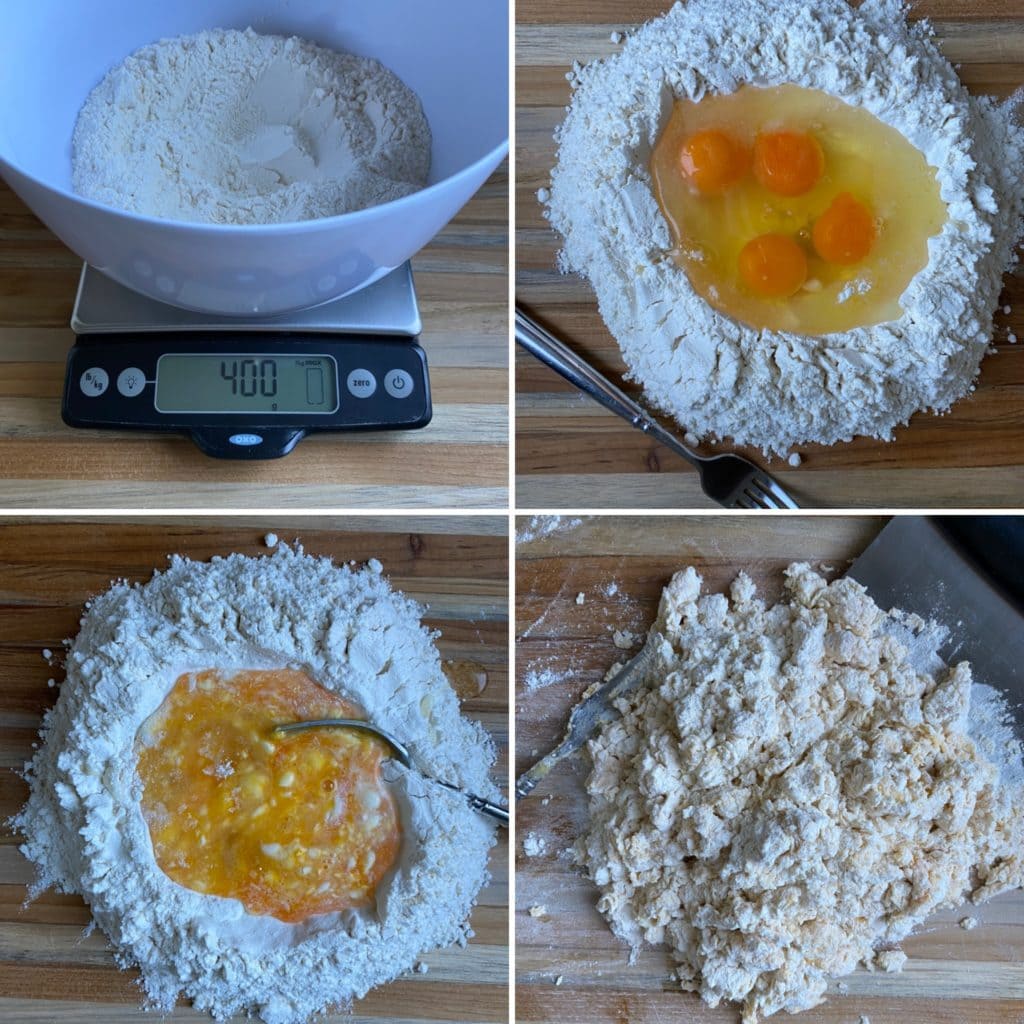
Top left to bottom right. Weigh your flour! Here is a good and inexpensive scale if you don’t have one.
I like to make a large well in the flour using the bottom of the bowl or your fist*. Pour your eggs into the middle of the well. Break each egg then start to scramble the eggs. Slowly incorporate the flour with the egg until a crumble mixture is achieved.
Here are the stages of your pasta dough:
- Raw egg and flour. When you break your egg in the flour well.
- Scrambled egg in the flour well. This is when you scramble your egg in the flour well as if you are making scrambled eggs. You will not have much flour at this point.
- Cake batter stage. Mix the scrambled egg with SOME (not all) of the flour and beat until you create a cake batter-like thickness. Then slowly incorporate more flour for the next stage.
- Crumble of egg and flour. This is where you start to add more and more flour a bit at a time into the scrambled egg mixture.
- Unified dough ball. This is when the egg and flour are well incorporated and form a cohesive ball.
You can use a dough scraper to help you. Here is a good and inexpensive dough scraper Use good quality farm fresh eggs for a nice colorful dough and superior taste.
*If you don’t want to mix the eggs into the flour on the counter or cutting board you can do it right in the mixing bowl. Use a fork and mix to incorporate. Once the dough reaches a crumble mixture move to counter top to start kneading.
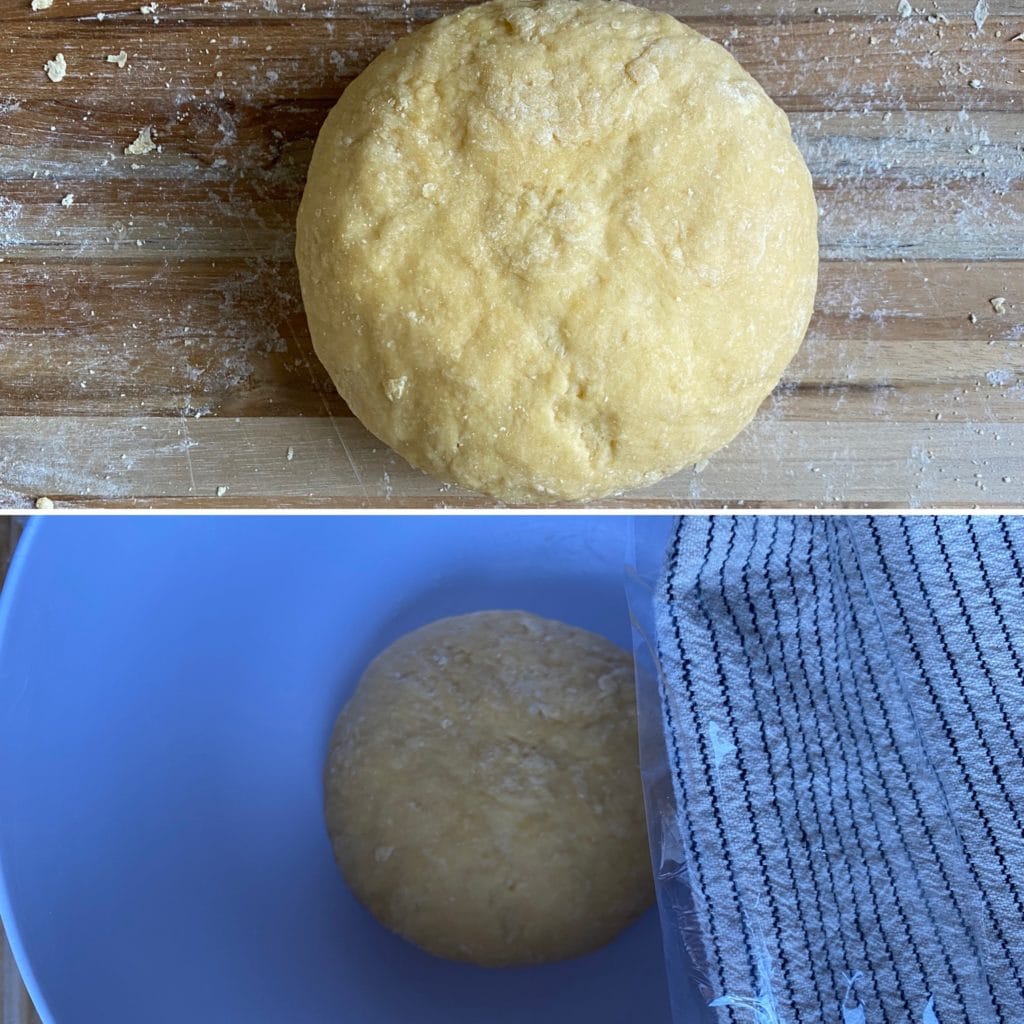
Top to bottom. Set a timer and knead the dough for about 10 minutes until a smooth dough ball forms*. You can also place the dough in a stand mixer with a dough hook to knead.
Rest the pasta dough. Put the dough in a large clean bowl, cover with plastic wrap and let it rest for 30 minutes to overnight.
*You can also place the dough in a stand mixer with the paddle attachment and knead the dough that way.
Rolling Fresh Pasta Dough
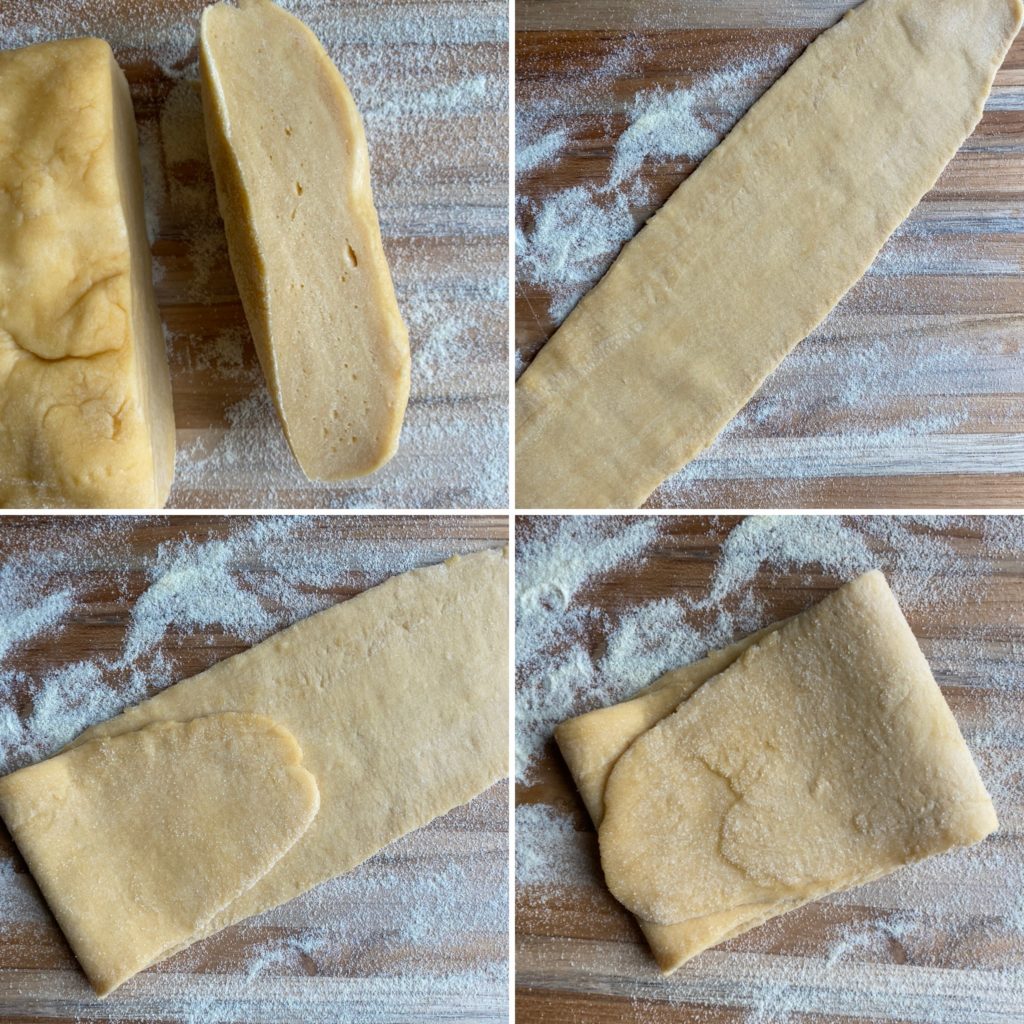
Top left to bottom right. After the dough has rested (don’t forget to do your “spring back test” listed in the tips above) begin by cutting the dough into fourths, one section as needed, and covering the rest while you work with one piece of dough.
Link to the trusted pasta machine I use and love.
Flatten the pasta dough a bit with your hands and run it through your pasta machine on setting #1, or the first setting*.
Fold the ends of the rolled out dough into the middle to make a rectangle. Send it through the pasta maker again with setting #1.
Add a little semolina flour, as needed, to keep it from sticking.
*ROLLING PIN (BY HAND METHOD) If you are rolling out the dough with a rolling pin follow these steps.
Divide the dough into four sections and work with one at a time while keeping the others covered.
Use semolina to dust the top and bottom to keep it from sticking. Keep rolling out the dough in a rectangular shape until you can see your hand on the other side when you hold it to the light.
Cut as directed with instructions below and repeat with the remaining dough. Cover unused dough with plastic wrap to keep it from drying.
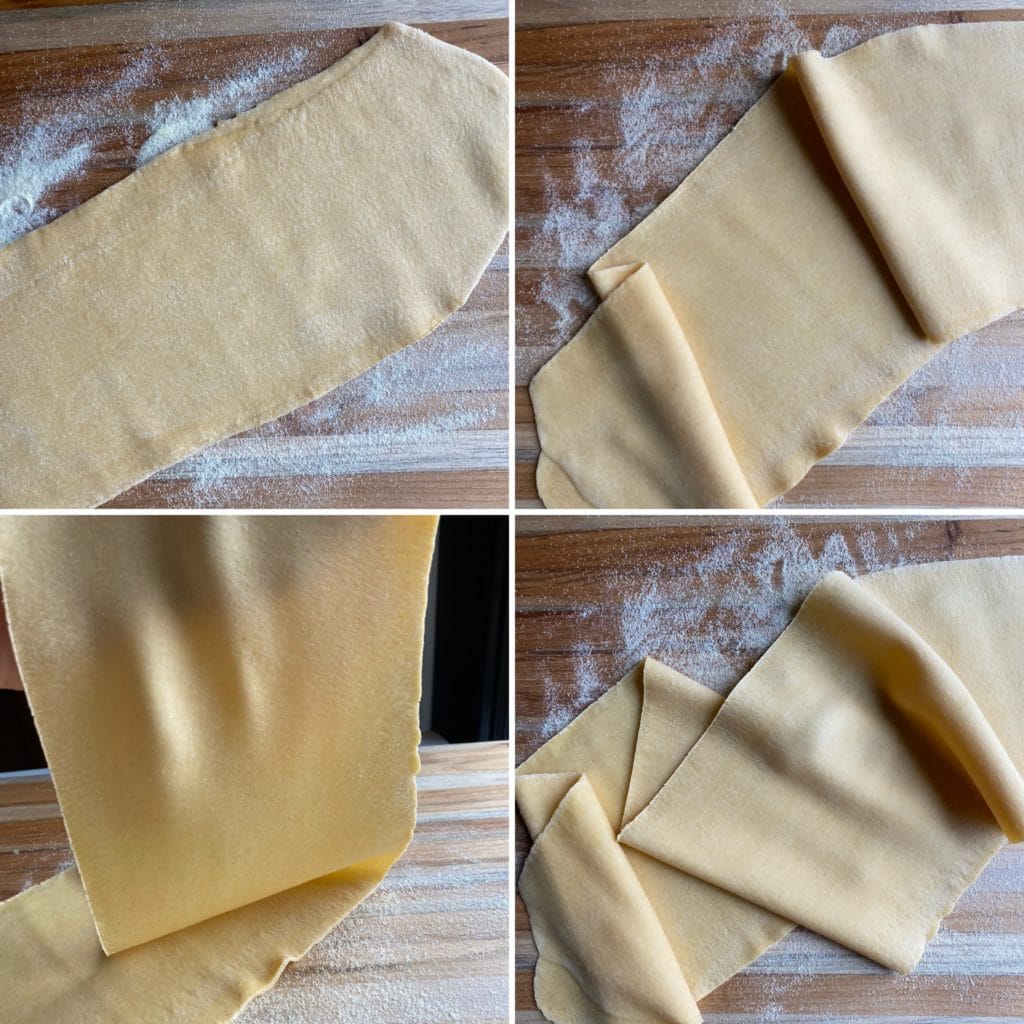
Top left to bottom right. Keep rolling out the dough with the pasta maker settings going from #1 all the way to #7. Dust both sides of the dough with a little semolina so it doesn’t stick in the pasta machine.
Window test. You will know when it is thin enough by holding your hand to the light. You will be able to see your hand through the pasta sheet.
My favorite affordable pasta maker BEST PRICE!
Cutting Fresh Pasta Dough
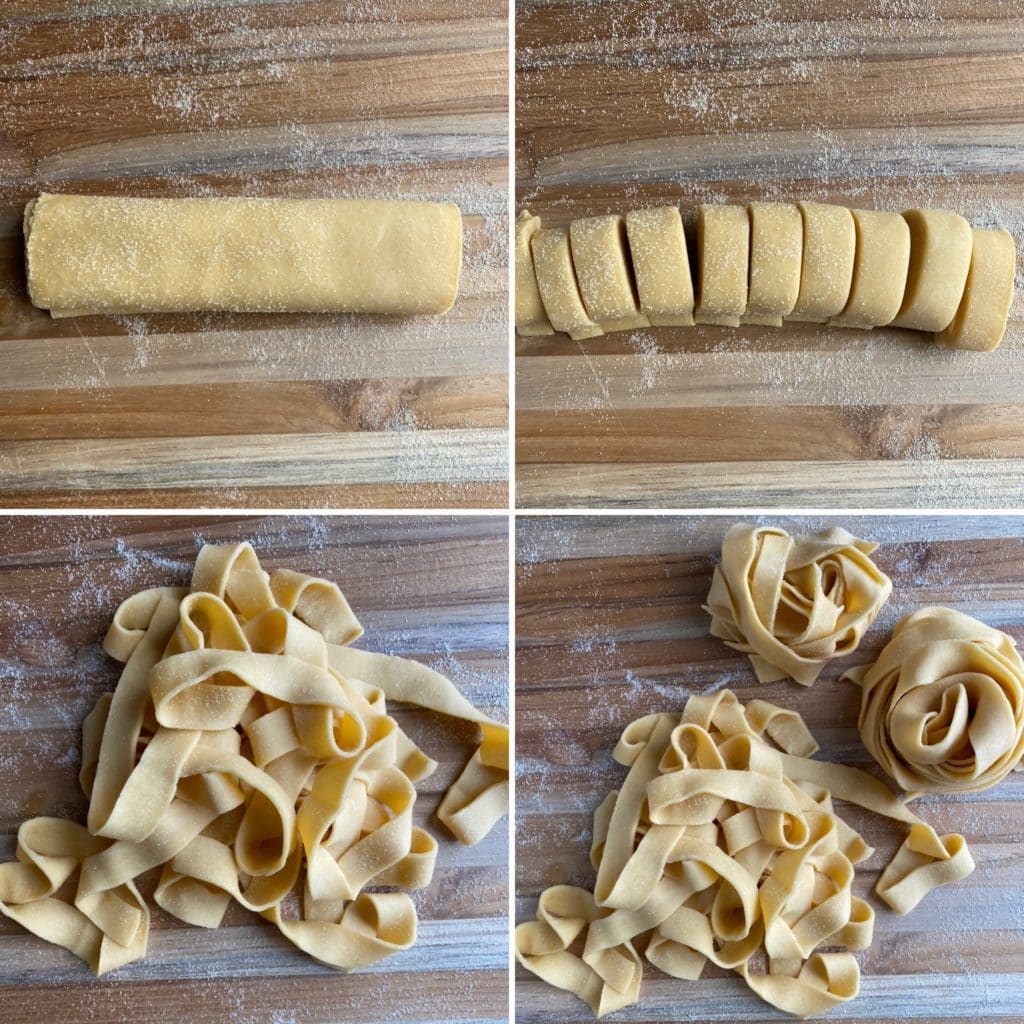
Top left to bottom right.
Cut the pappardelle. Dust the top of the sheet of dough with semolina flour and loosely roll it into a cylinder. Using a sharp knife, cut into 3/4-inch-wide slices (wider or thinner depending on how you like it).
Unwrap the pappardelle pasta; dust with semolina and gently toss to separate. Place on a sheet pan and cover with a tea towel until ready to cook (or freeze in freezer bags for up to 2 months). You can make them into little nests to store them, or simply put them into a freezer-safe bag.
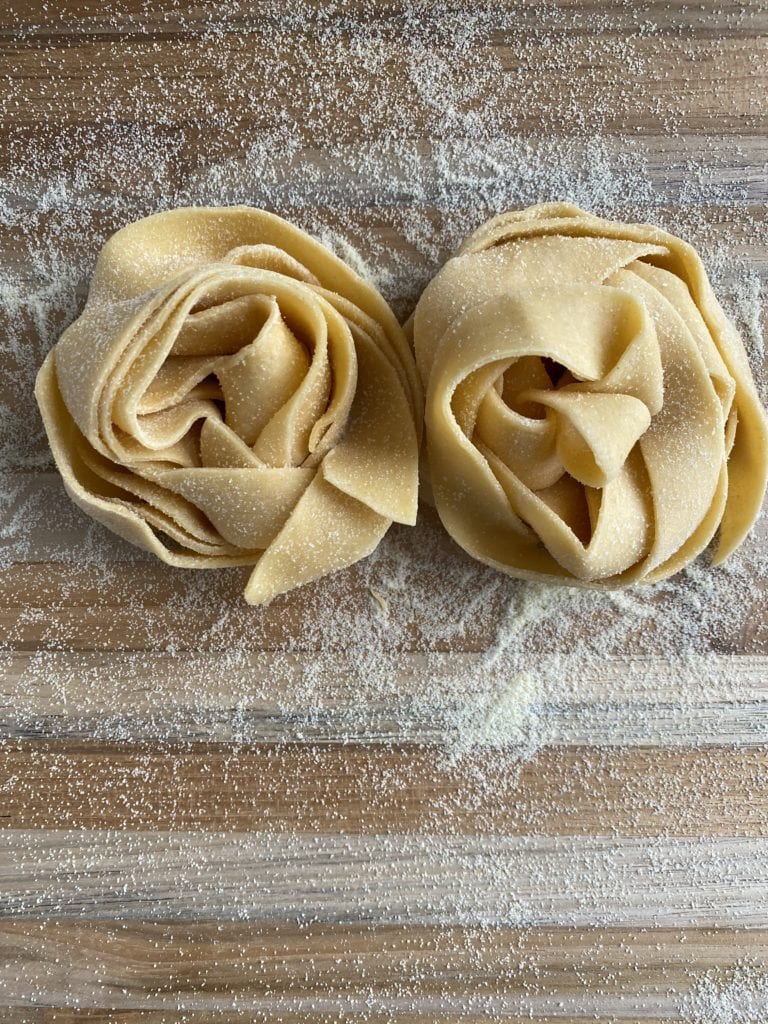
The Italian word derives from the verb “pappare”, to gobble up, or eat hungrily.
The names “00 “and “0” flour refer to specifically Italian milled flour that is used for making pasta, bread, and pizza. The grading system is 2, 1, 0 or 00 and indicates to how finely ground the flour is and how much of the bran and germ have been removed.
2, for instance, is wholemeal flour while 00 is the most refined of the three and has the lowest level of bran. It is similar to unbleached all-purpose/plain flour, which is a mix of hard and soft wheat, and while finer, it creates a dough that is silkier and maintains a chewiness when the pasta is cooked. With that said, All-purpose flour is perfectly fine to use for making homemade pasta.”
Semolina is flour made from ground durum wheat. It’s rich in protein, fiber, and B vitamins and may support weight loss, heart health, and digestion. It is high protein content is great for improving the structure and texture of recipes like pasta and bread. This is the semolina flour I use.
Semolina is more coarse and won’t stick to the pasta as much as regular flour. Semolina is great to prevent sticking but it won’t ‘cake’ onto the pasta like flour so it keeps the pasta lighter and easier to digest without so much of the added white flour. It keeps that pasta later as an end result.
When the pasta is ready to cook it won’t have an excess layer of raw flour that will cause the water to get cloudy looking. It also doesn’t make for the right kind of pasta water to save as a binder for the sauce.
Traditionally pappardelle is always made with egg. You can find recipes that use other ingredients but the texture of the pasta will be very different from traditional pappardelle.
Many people confuse pappardelle with tagliatelle. They are both egg pastas but are different sizes. Pappardelle is thinner and cut into one inch strips while tagliatelle is cut into longer ribbons.
PRO TIPS
- Weigh your ingredients! This yields to a tender and perfectly hydrated dough. Here is a good and inexpensive scale if you don’t have one.
- Knead the dough. After you incorporate the eggs and flour make sure you really knead the dough into a smooth ball. We don’t want clumps of flour in our dough!
- Rest the dough. Let the dough rest for 15-30 minutes in the fridge, or on the counter. During this time the water will be absorbed by the flour and the gluten strands will relax, giving a strong, pliable, roll-able dough.
- The higher the yolk content, the more it needs to rest. When made only with yolks needs to rest for 6 hours (that doesn’t apply to this particular dough since it also uses egg whites).
- Spring back test. To know if your dough has rested. This is where you press down on the dough after it has rested and it bounces back ever so slightly to show the gluten is relaxed.
- Roll out the dough. Make sure you never feed the pappardelle pasta dough through the machine when it is sticky. Always make sure you sprinkle some extra semolina flour on top and bottom before you feed it through the machine. If you are using a rolling pin the same rule applies!
- Don’t overcook the pasta. You’ve worked so hard for this! Don’t ruin the fresh pasta by overcooking it. Fresh pasta takes considerably less time to cook than dried, usually 1 to 3 minutes, so watch it carefully.
- To test, remove a noodle with tongs or a long-handled fork and take a bite. Serve with your favorite sauce and Mangia! (Eat!)
My biggest advice when making homemade pasta is to practice. Make it a few times and really get a feeling of the dough.
Maybe you like them a little thinner or thicker? Cut wider or smaller? Play with the dough and have fun while learning the process!
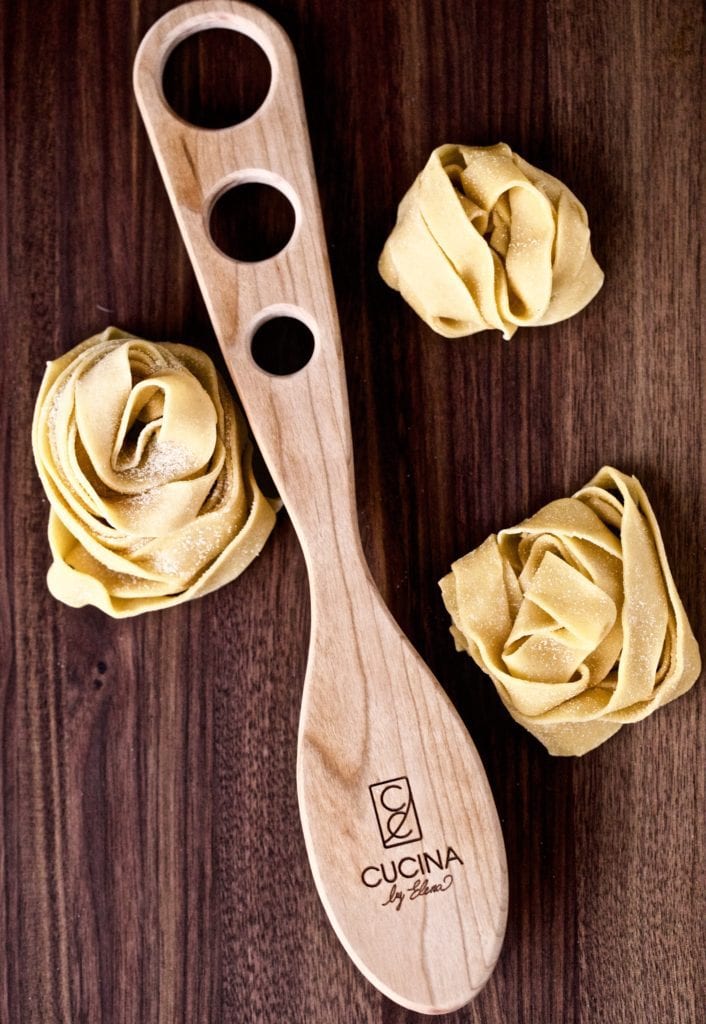
How to Cook Fresh Pasta
Cook the pappardelle noodles in a large pot of boiling salted water. (Use about 4 quarts of water for 1 pound of pasta.) Fresh pasta takes considerably less time to cook than dried, usually 1 to 3 minutes, so watch it carefully.
Read How Long to Boil Pasta- Perfect Every Time for more on cooking fresh pasta.
To test, remove a noodle with tongs or a pasta server spoon and take a bite. Serve with your favorite sauce. You will love this recipe!
Sauce Recommendations
Enjoy pappardelle in a range of delicious pasta recipes. These thick, wide pasta ribbons work well in rich meat ragu sauces as well as veggie sauces and pestos.
SMOKED SALMON MASCARPONE AND PEAS
PICCATA with MUSHROOM AND ASPARAGUS
Beef Short Rib Ragu with Pappardelle Pasta
Creamy Ricotta and Roasted Red Pepper Sauce
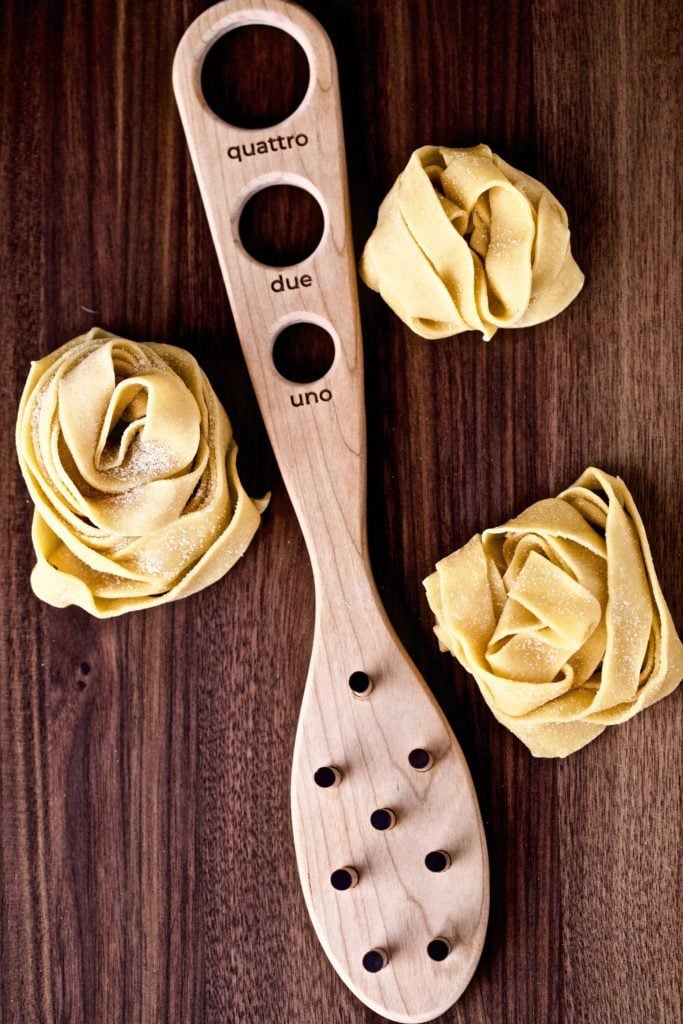
3 Ways to Store Fresh Pasta
There are multiple ways to store fresh pasta. Follow the directions below for storing and freezing uncooked, fresh pasta:
- Store in the refrigerator: You can store fresh homemade pasta in the refrigerator in an airtight container for a day.
- Freeze fresh pasta dough: Wrap the dough in plastic wrap and place it in an airtight container or freezer bag. The pasta dough will keep for up to a month. Thaw the dough overnight in your refrigerator before using it.
- Freeze fresh pasta: Toss the pasta in a little semolina to keep them from sticking, then lay the pasta noodles in a single layer on a baking tray. Or, you can form the pasta noodles into little nests.
- Let the pasta air dry for one hour, then put the semi-dry pasta in a freezer-safe plastic bag or airtight container. The frozen pasta will last for eight months. You can put the frozen pasta straight into boiling water to cook them. Do NOT thaw frozen pasta dough.
Source: Master Class
Have you checked out my NEW CBE PRODUCTS? Take a look at the 2-in-1 cutting and charcuterie board, gorgeous apron, and unique pasta server that you absolutely need! The wood products are all handmade in Salt Lake City, Utah. They make great gifts as well!
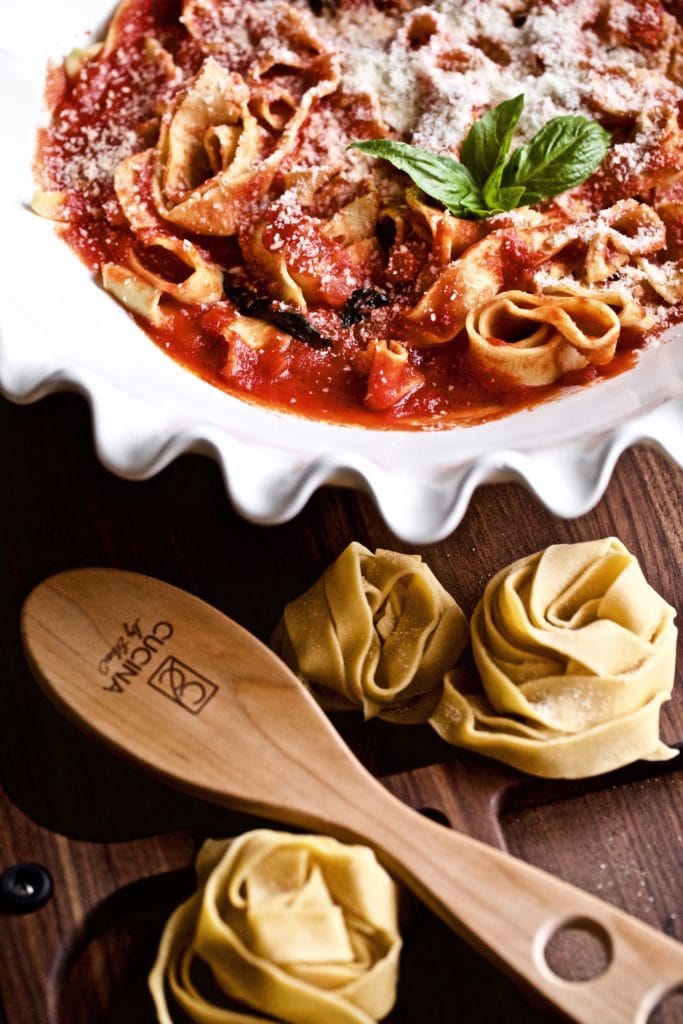
Making Pasta with Family and Friends
When I was little we didn’t make homemade pasta very often. It was more of a treat or family activity. Homemade pasta is easy to make but it does require a little time and with two full-time working parents making fresh pasta daily/weekly wasn’t possible.
I now make homemade pasta with my children, especially in the winter when it’s cold outside, as a cozy and delicious pastime. We make a day out of pasta making and get our hands in the dough.
I am sharing this pappardelle pasta recipe and guide to bring the same memories to your kitchen with you and yours! Make it a date night or girls’ night with fresh homemade pappardelle.
Made with Amore, Elena
From my Cucina to your Table, Mangia! Mangia! (Eat!)
Making homemade pappardelle pasta is therapeutic and satisfying. It is a fun family activity or one to enjoy as a date night project. There is something about mixing the dough with your hands, creating a delicious product, and then eating the fruits of your labor.
Print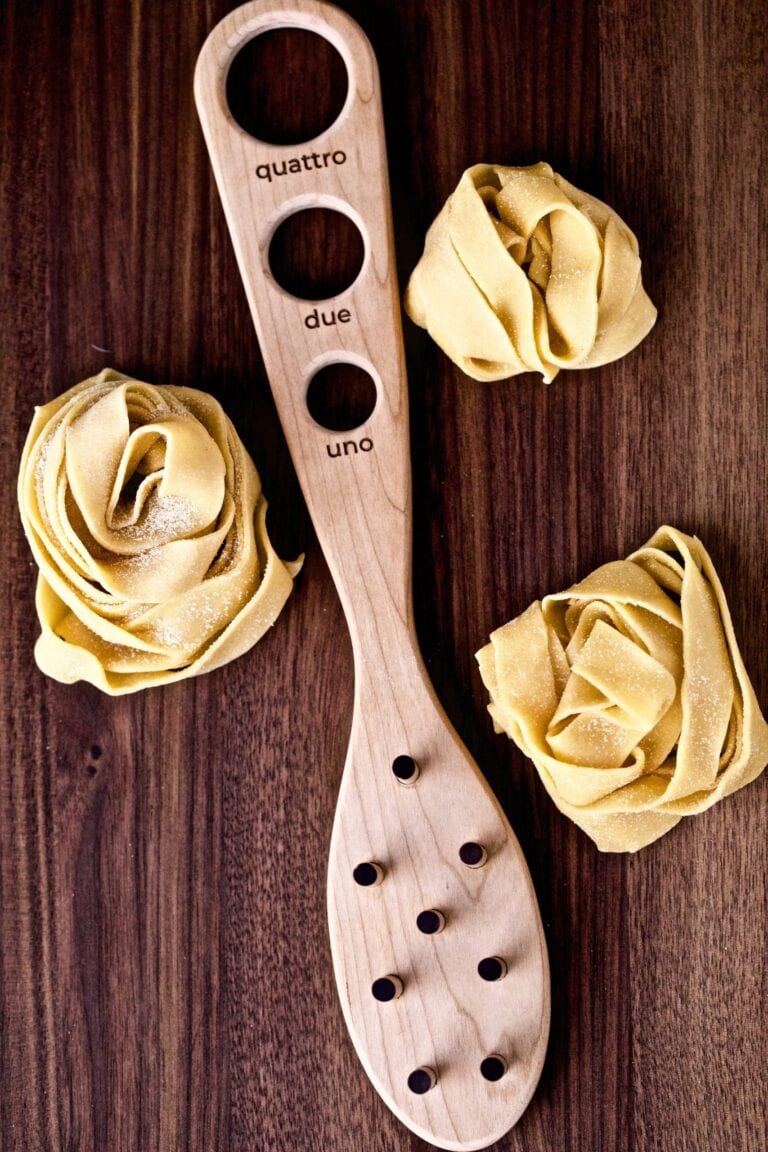
Pappardelle Pasta Recipe
Making pasta is therapeutic and satisfying. It is a fun family activity or one to enjoy as a date night project. This is an easy recipe that you will come to when you crave those thick and delicious pappardelle pasta noodles. If you’ve never made fresh pasta this is a great recipe to get you started!
- Total Time: 60 minutes
- Yield: 8 servings 1x
Ingredients
- 4 free-range eggs (room temperature)
- 400g/14.10 oz tipo “00” or plain all-purpose flour (highly recommend weighing flour)
- Semolina flour for dusting pasta
Instructions
- Make the dough. Sift the flour on a large work surface and make a well in the center (I like to use the bottom of a bowl to make the well). Place the eggs in a bowl, then pour into the well; with a fork, break up the eggs (like you are making scrambled eggs), then gradually mix the wet ingredients into the flour mixture just until combined. Start a little at a time and create a cake batter consistency then incorporate more of the flour until a crumble consistency form. The dough may look dry and crumbly at this point. (See Notes for more)
- If you have a dough scraper you can use it to help you incorporate the ingredients.
- Knead by hand. Dust a wooden board or work surface with flour. Start kneading each piece, push the dough away from you with the heel of your hand, fold the dough over itself and turn it counterclockwise.
- Continue pushing, folding, and turning until the dough is smooth and elastic about 10 minutes. You can also knead it in a stand mixer.
- Let dough Rest. Pat the dough into a round ball. Flatten the top slightly with your hand, wrap it in plastic wrap and refrigerate for at least 30 minutes or overnight. You will know your dough is ready when it springs back after you push into the dough. I call this the “spring back test”.
- Roll out the dough. Sprinkle a large cutting board or clean the work surface with semolina. Cut 1/4 of the rested dough ball and keep the other part covered with plastic wrap so it doesn’t dry.
- Rolling Pin Method: Starting in the middle, push away from you with a rolling pin, easing up on the pressure as you approach the edge.
- Dust both sides of the dough with a little semolina so it doesn’t stick to the rolling pin and cutting board. Continue rolling the dough into a sheet, turning occasionally, until you can see your fingers through the bottom of the dough if you hold it to the light.
- Let the flat and rolled-out dough dry for about 10 minutes before cutting. You will repeat this step with all the pasta dough pieces.
- Pasta Maker Method: If you have a pasta maker you can run it through the machine. Start with setting #1. Feed through the machine once then fold each side into the middle to form a rectangle. Put it through the machine again on setting #1.
- Dust both sides of the dough with a little semolina so it doesn’t stick in the pasta machine, and repeat as needed. Now, repeat feeding through the machine and changing the setting each time from #2, #3, #4, #5, #6, until you reach setting #7- OR- until you can see your fingers through the bottom of the dough if you hold it to the light.
- Let the flat and rolled-out dough dry for about 10 minutes before cutting. You will repeat this step with all the pasta dough pieces. (see photos in post for visual aid)
- Cut the pappardelle. Dust the top of the sheet of dough with semolina flour and loosely roll it into a cylinder. Using a sharp knife, cut into 3/4-inch-wide slices.
- Unwrap the pasta; dust with semolina and gently toss to separate. Place on a sheet pan and cover with a tea towel until ready to cook (or freeze in freezer bags for up to 2 months). You can make them into little nests to store them or simply put them into a freezer-safe bag.
- Cook the pappardelle. Cook fresh pasta noodles in a large pot of boiling salted water. (Use about 6 quarts of water for 1 pound of pasta.) Fresh pasta takes considerably less time to cook than dried, usually 1 to 3 minutes, so watch it carefully. To test, remove a noodle with tongs or a pasta server spoon and take a bite.
- Serve with your favorite sauce- I list my favorites in the recipe post. Mangia! (Eat!)
Notes
Stages of Pasta Dough:
- Raw egg and flour. When you break your egg in the flour well.
- Scrambled egg in the flour well. This is when you scramble your egg in the flour well as if you are making scrambled eggs. You will not have much flour at this point.
- Cake batter stage. Mix the scrambled egg with SOME (not all) of the flour and beat until you create a cake batter-like thickness. Then slowly incorporate more flour for the next stage.
- Crumble of egg and flour. This is where you start to add more and more flour a bit at a time into the scrambled egg mixture.
- Unified dough ball. This is when the egg and flour are well incorporated and form a cohesive ball.
- Prep Time: 30 min + chill time
- Cook Time: 5 minutes
- Category: Savory
- Method: Italian
- Cuisine: Italian
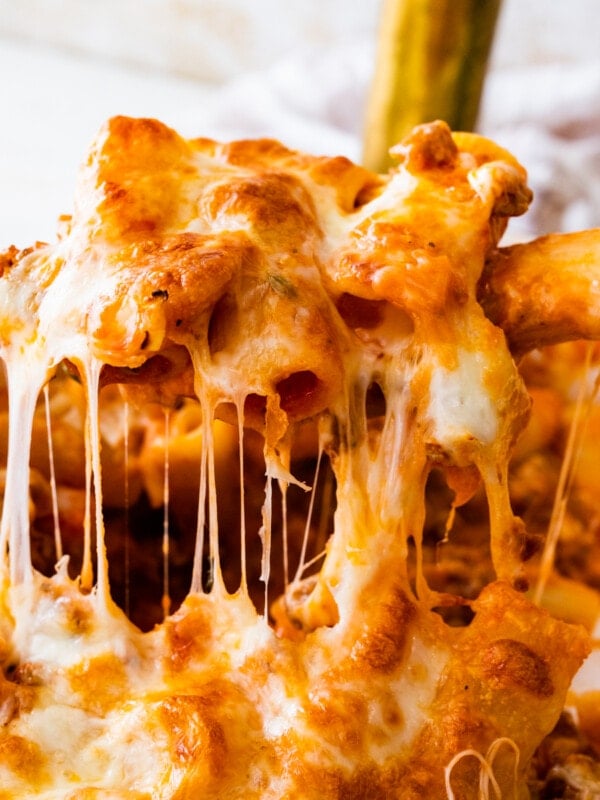
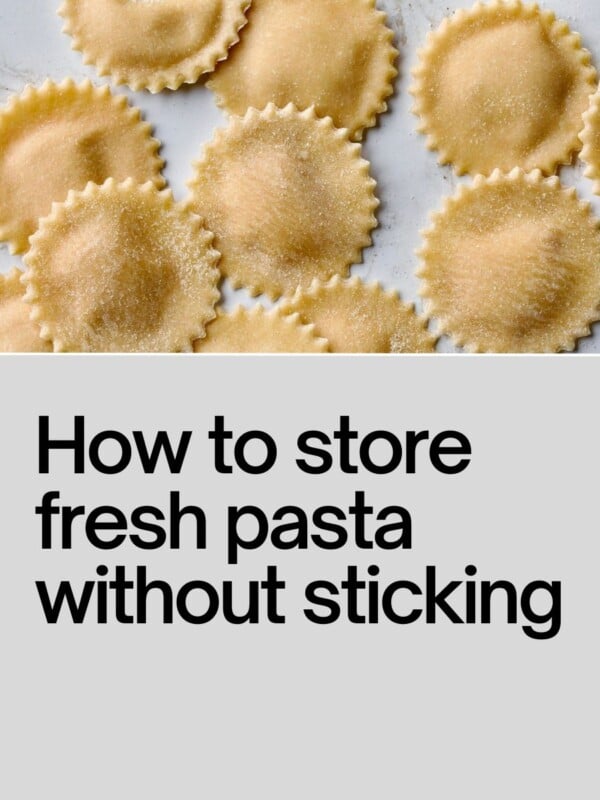
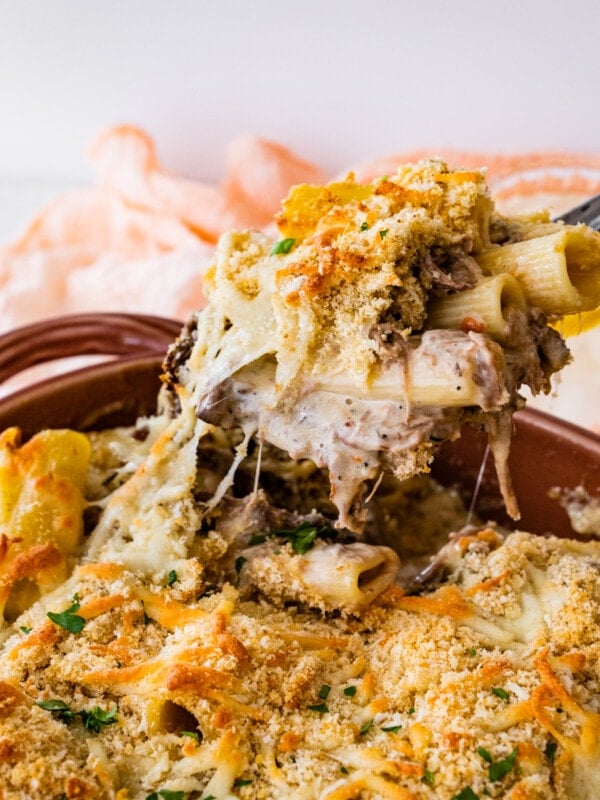
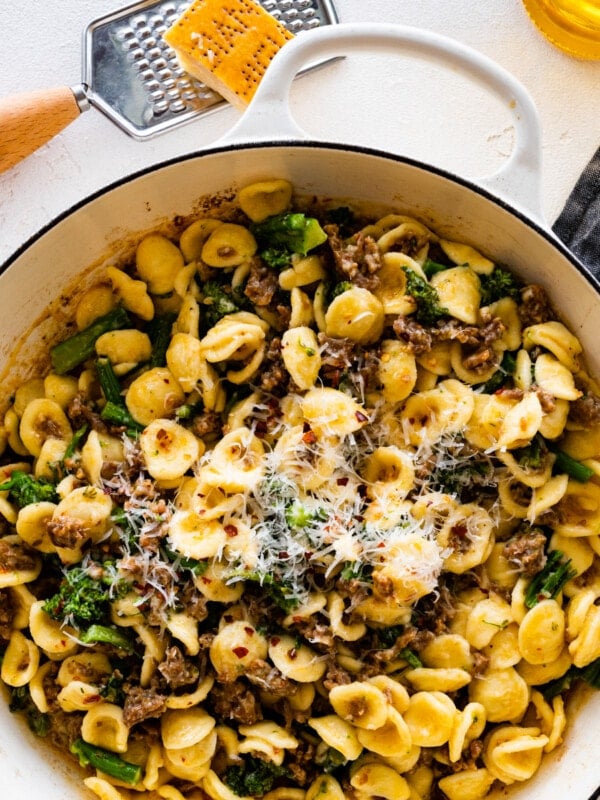




This was so easy to make, had the perfect consistency and tasted delicious!!
Happy you loved it! Homemade pasta is the best!
How long could you leave it sitting before cooking it? I’d like to try my hand at this on Friday for a family dinner, but if I make it Friday afternoon can it sit until 6:00 pm or so that night? Or should I put it in the fridge?
Hi! You will want to put it in the fridge after a couple of hours!